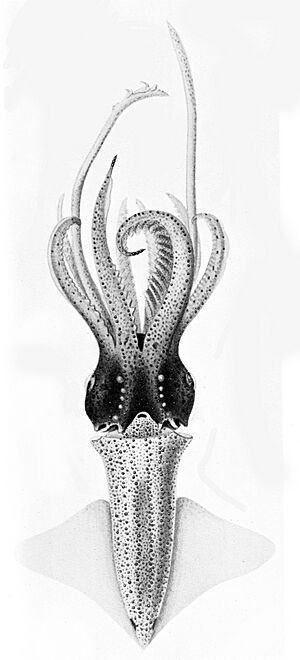Abraliopsis morisii facts for kids
Quick facts for kids Abraliopsis morisii |
|
|---|---|
 |
|
| Conservation status | |
| Scientific classification | |
| Genus: |
Abraliopsis
|
| Species: |
morisii
|
| Synonyms | |
|
|
The Abraliopsis morisii is a special kind of squid. It's known for being bioluminescent, which means it can make its own light! This amazing squid lives in the Atlantic Ocean, including the Gulf of Mexico and the Mediterranean Sea. It likes warm waters, from tropical areas to slightly cooler ones.
You can find Abraliopsis morisii in the upper parts of the ocean, called the epipelagic and mesopelagic zones. These squids are quite small, growing to about 25 to 33 millimeters long. That's about the size of a large paperclip! A scientist named Jean Baptiste Vérany first described this species in 1839. The International Union for Conservation of Nature (IUCN) says this squid is a "least concern" species, meaning it's not currently in danger.
Contents
What Does Abraliopsis morisii Look Like?
Male A. morisii squids become adults in about 120 to 130 days. Females take a bit longer, usually 150 to 160 days. However, some have been seen to mature faster!
These squids have special light-producing organs called photophores. They are scattered all over their skin. They also have five of these light organs around their eyes.
Male squids have a special arm called a hectocotylus. It has a long flap on one side and a short flap on the other. Adult males can grow to about 25 to 27 millimeters long. Females are a bit bigger, reaching about 32 to 33 millimeters in length. Female squids can lay a lot of eggs, usually between 6,500 and 21,000! Each egg is tiny, about 1.0 to 1.1 millimeters long.
Where Does Abraliopsis morisii Live?
This squid lives in many parts of the Atlantic Ocean, the Mediterranean Sea, and the Gulf of Mexico. It has been found at different depths, from as shallow as 15 meters to as deep as 3,417.5 meters. That's super deep!
It can live in waters with temperatures from about 2.3 degrees Celsius (36 degrees Fahrenheit) to 22.9 degrees Celsius (73 degrees Fahrenheit). Scientists have found it in areas with lots of important nutrients like nitrate and phosphate. It also likes places with good oxygen levels. Because it lives in such a wide area, the IUCN considers it a least-concern species. This means it's not currently at risk of disappearing.
How Was Abraliopsis morisii Named?
The Abraliopsis morisii was first described by Jean Baptiste Vérany in 1839. He originally gave it the name Onychoteuthis morisii. Over time, it has been known by a few other names too, like Abralia jattai and Abraliopsis pfefferi. These different names are called synonyms.
Gallery
-
Abraliopsis morisii from Carl Chun's Die Cephalopoden



